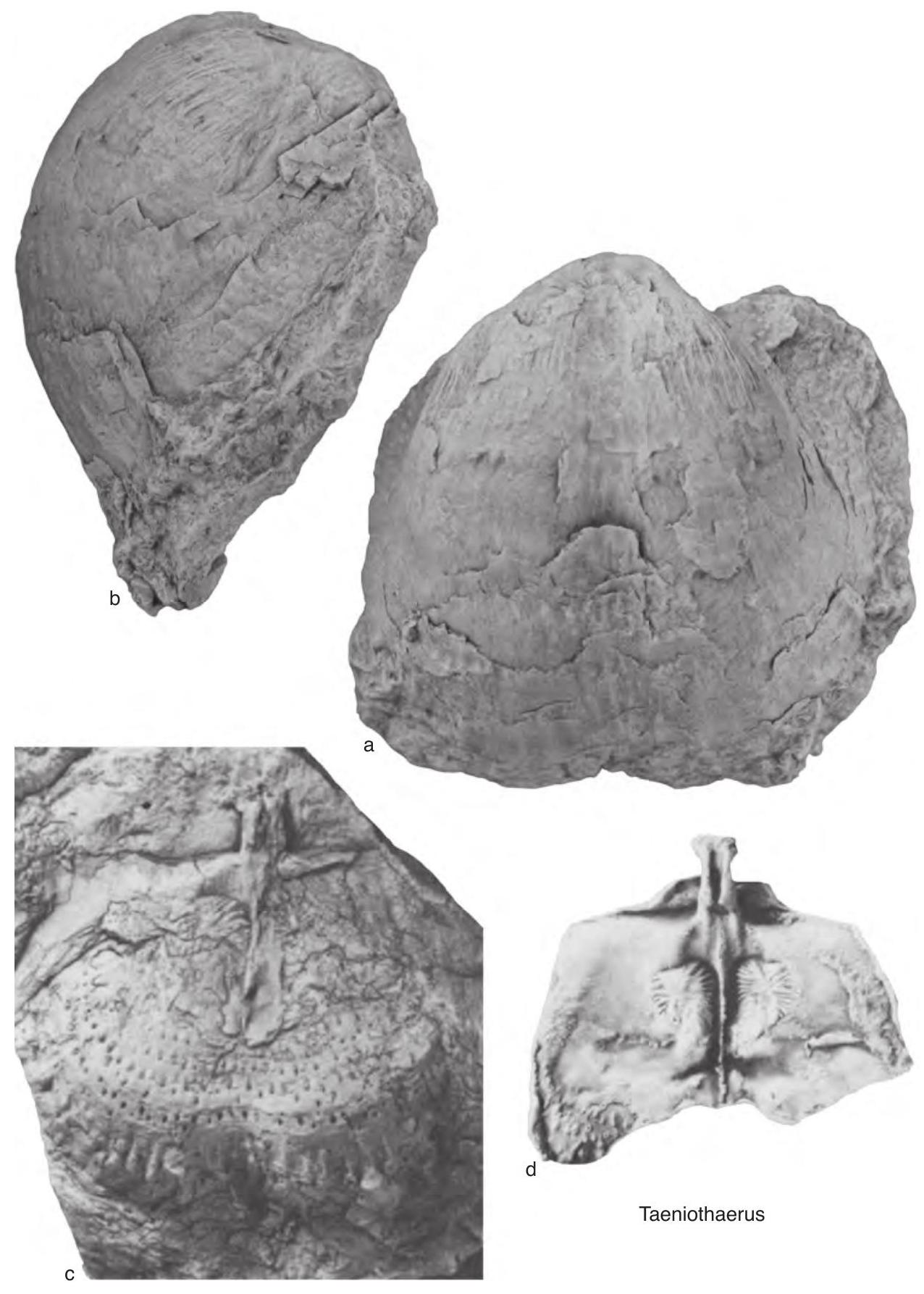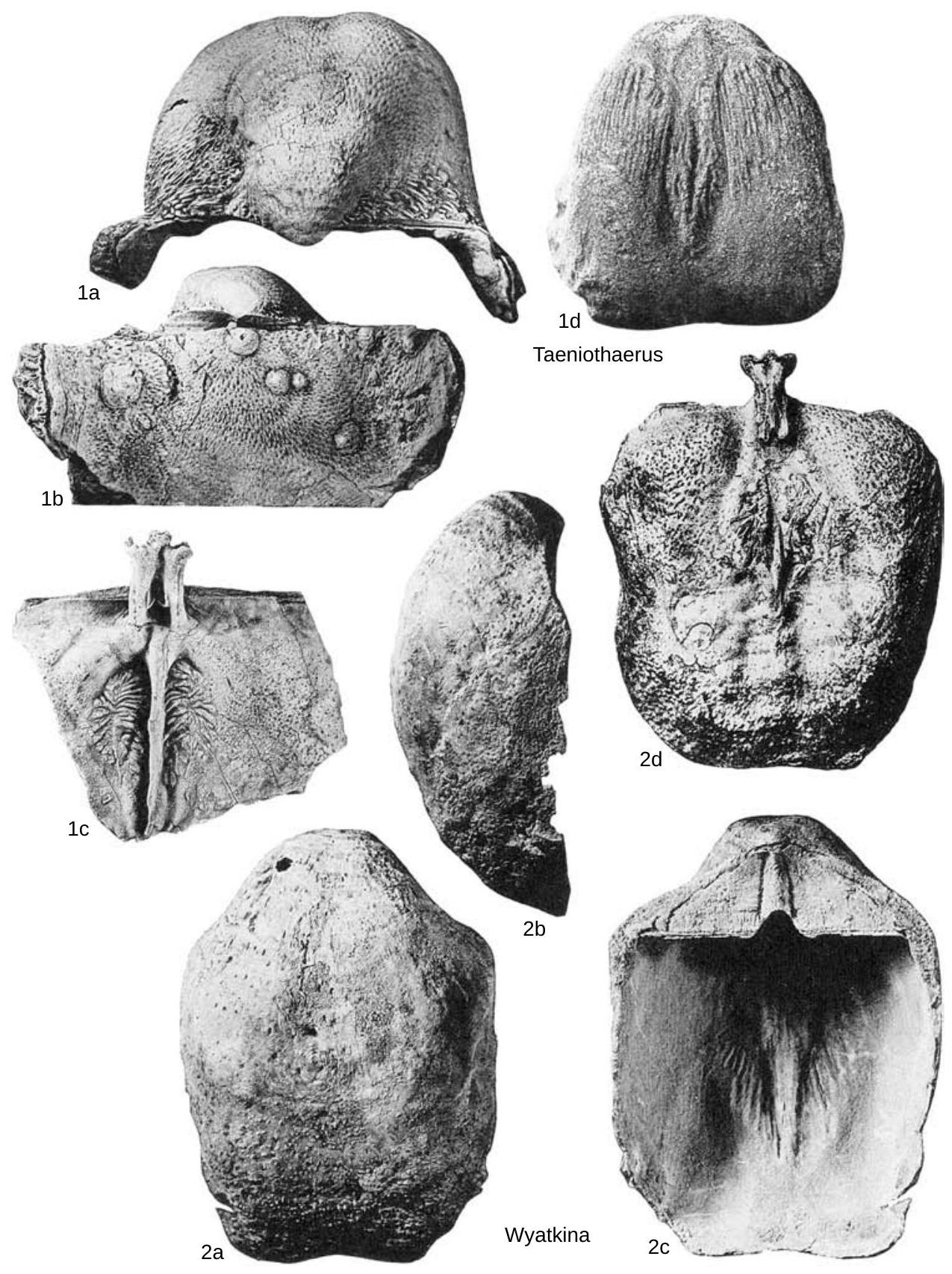Welcome to the Treatise on Invertebrate Paleontology!
Please enter a genera name to retrieve more information.

Taeniothaerus
Classification
Phylum:
Brachiopoda
Subphylum:
Rhynchonelliformea
Class:
Strophomenata
Order:
Productida
Suborder:
Strophalosiidina
Superfamily:
Aulostegoidea
Family:
Aulostegidae
Subfamily:
Agelesiinae
Formal Genus Name and Reference:
Taeniothaerus WHITEHOUSE, 1928, p. 281
Type Species:
P. subquadratus Morris in STREZELECKI, 1845, p. 284, OD
Images
(Click to enlarge in a new window)
Fig. 1778 a-d. * T. subquadratus (Morris), a-b, lectotype, partly exfoliated ventral valve exterior viewed ventrally and laterally, near Hobart, Tasmania, BMNH B91171, x1 (new), c, dorsal valve interior with exposed external mold anteriorly showing positions of spine bases, Berriedale Limestone, near Granton, Tasmania, x0.8, d, incomplete dorsal valve interior, Counsel Creek Formation, Maria Island, Tasmania, × 1 (Parfrey, 1983). ——Fig. 1779 a–b. * T. subquadratus ( Morris); a, ventral valve exterior showing finer spines anteriorly, Enstone Park Limestone, Elephant Pass, Tasmania, ×0.6 (Parfrey, 1983); b, replica of ventral valve exterior, Tiverton Formation, × 1 (Waterhouse, Briggs, & Parfrey, 1983).
Synonyms
Geographic Distribution
eastern Australia
Age Range
Beginning Stage in Treatise Usage:
Lower Permian (Artinskian)
Beginning International Stage:
Artinskian
Fraction Up In Beginning Stage:
0
Beginning Date:
290.51
Ending Stage in Treatise Usage:
Lower Permian (Artinskian)
Ending International Stage:
Artinskian
Fraction Up In Ending Stage:
100
Ending Date:
283.3
Description
Large, relatively thick-shelled, sulcate ventral valve with irregular concentric bands of coarse, elongate spine bases and relatively thick spines interspersed with fewer finer spines anteriorly, plus stronger posterolateral spines, dorsal valve with concentric coarse dimples and few spines, dorsal adductor scars posteriorly bordered by ridges extending from the cardinal process shaft. [The erection of Carilya results in the need for a redefinition of this genus.]
References
Museum or Author Information
Classification
Phylum:
Brachiopoda
Subphylum:
Rhynchonelliformea
Class:
Strophomenata
Order:
Productida
Suborder:
Strophalosiidina
Superfamily:
Aulostegoidea
Family:
Aulostegidae
Subfamily:
Agelesiinae
Formal Genus Name and Reference:
Taeniothaerus WHITEHOUSE, 1928, p. 281
Type Species:
P. subquadratus Morris in STREZELECKI, 1845, p. 284, OD
Images
(Click to enlarge in a new window)
Fig. 1778 a-d. * T. subquadratus (Morris), a-b, lectotype, partly exfoliated ventral valve exterior viewed ventrally and laterally, near Hobart, Tasmania, BMNH B91171, x1 (new), c, dorsal valve interior with exposed external mold anteriorly showing positions of spine bases, Berriedale Limestone, near Granton, Tasmania, x0.8, d, incomplete dorsal valve interior, Counsel Creek Formation, Maria Island, Tasmania, × 1 (Parfrey, 1983). ——Fig. 1779 a–b. * T. subquadratus ( Morris); a, ventral valve exterior showing finer spines anteriorly, Enstone Park Limestone, Elephant Pass, Tasmania, ×0.6 (Parfrey, 1983); b, replica of ventral valve exterior, Tiverton Formation, × 1 (Waterhouse, Briggs, & Parfrey, 1983).
Synonyms
Geographic Distribution
eastern Australia
Age Range
Beginning Stage in Treatise Usage:
Lower Permian (Artinskian)
Beginning International Stage:
Artinskian
Fraction Up In Beginning Stage:
0
Beginning Date:
290.51
Ending Stage in Treatise Usage:
Lower Permian (Artinskian)
Ending International Stage:
Artinskian
Fraction Up In Ending Stage:
100
Ending Date:
283.3
Description
Large, relatively thick-shelled, sulcate ventral valve with irregular concentric bands of coarse, elongate spine bases and relatively thick spines interspersed with fewer finer spines anteriorly, plus stronger posterolateral spines, dorsal valve with concentric coarse dimples and few spines, dorsal adductor scars posteriorly bordered by ridges extending from the cardinal process shaft. [The erection of Carilya results in the need for a redefinition of this genus.]

